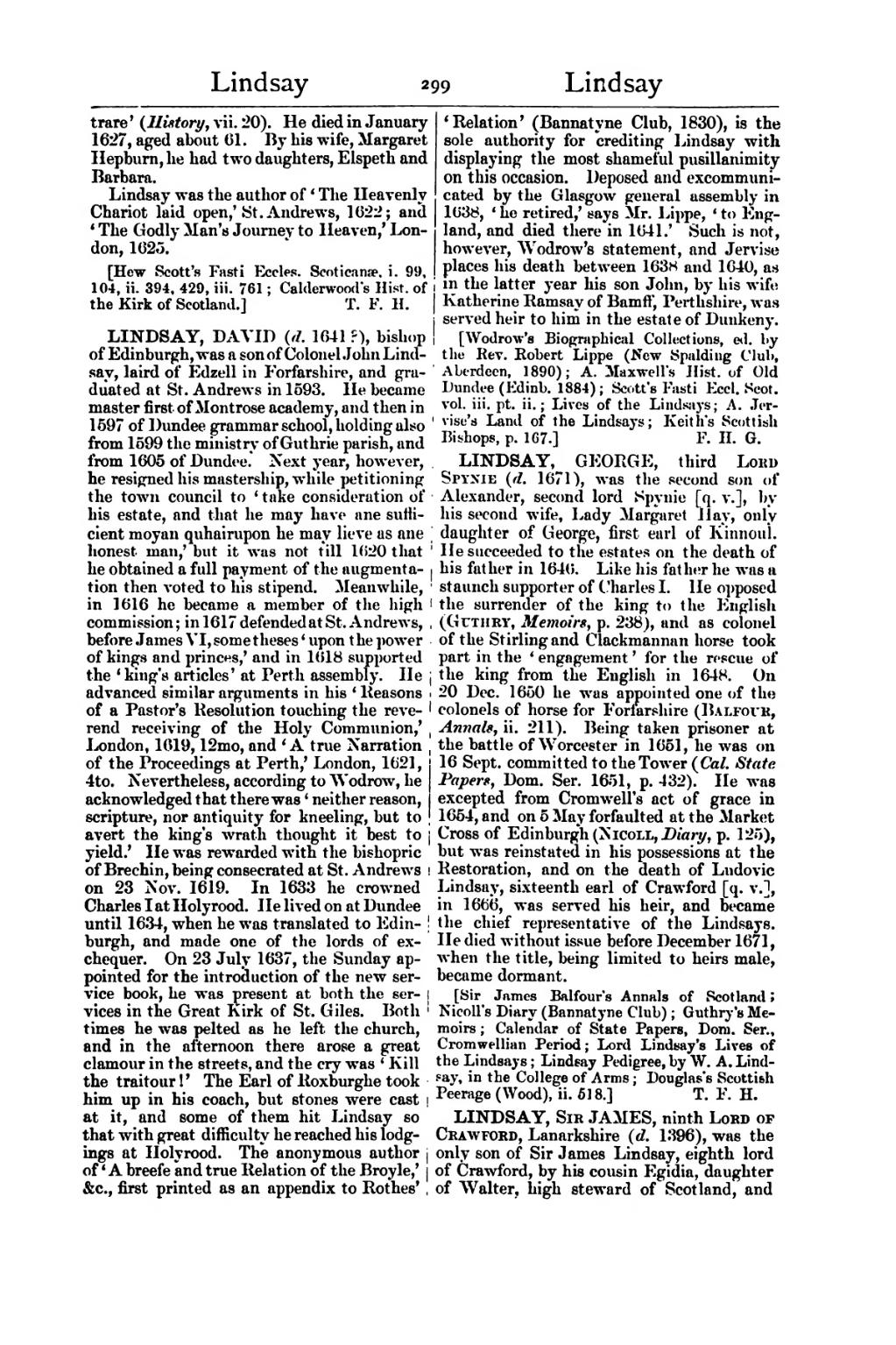trare' (History, vii. 20). He died in January 1627, aged about 61. By his wife, Margaret Hepburn, he had two daughters, Elspeth and Barbara.
Lindsay was the author of 'The Heavenly Chariot laid open,' St. Andrews, 1622'; and 'The Godly Man's Jouney to Heaven,' London, 1625.
[Hew Scott's Fasti Eccles. Scoticanæ, i. 99, 104, ii. 394, 429, iii. 761; Calderwood's Hist. of the Kirk of Scotland.]
LINDSAY, DAVID (d. 1641?), bishop of Edinburgh, was a son of Colonel John Lindsay, laird of Edzell in Forfarshire, and graduated at St. Andrews in 1593. He became master first of Montrose academy, and then in 1597 of Dundee grammar school, holding also from 1599 the ministry of Guthrie parish, and
from 1605 of Dundee. Next year, however,
he resigned his mastership, while petitioning the town council to 'take consideration of his estate, and that he may have ane sufficient moyan quhairupon he may lieve as ane honest man,' but it was not till 1620 that he obtained a full payment of the augmentation then voted to his stipend. Meanwhile, in 1616 he became a member of the high commission; in 1617 defended at St. Andrews, before James VI, some theses 'upon the power of kings and princes,' and in 1618 supported the 'king's articles' at Perth assembly. He
advanced similar arguments in his 'Reasons
of a Pastor's Resolution touching the reverendreceiving of the Holy Communion,'
London, 1619, 12mo, and 'A true Narration
of the Proceedings at Perth,' London, 1621, 4to. Nevertheless, according to Wodrow, he acknowledged that there was 'neither reason, scripture, nor antiquity for kneeling, but to avert the king's wrath thought it best to yield.' He was rewarded with the bishopric of Brechin, being consecrated at St. Andrews on 23 Nov. 1619. In 1633 he crowned Charles I at Holyrood. He lived on at Dundee until 1634, when he was translated to Edinburgh,
and made one of the lords of exchequer.
On 23 July 1637, the Sunday appointed
for the introduction of the new service
book, he was present at both the services
in the Great Kirk of St. Giles. Both
times he was pelted as he left the church,
and in the afternoon there arose a great
clamour in the streets, and the cry was 'Kill the traitour!' The Earl of Roxburghe took him up in his coach, but stones were cast at it, and some of them hit Lindsay so that with great difficulty he reached his lodgings at Holyrood. The anonymous author of 'A breefe and true Relation of the Broyle,' &c., first printed as an appendix to Rothes' 'Relation' (Bannatyne Club, 1830), is the sole authority for crediting Lindsay with displaying the most shameful pusillanimity on this occasion. Deposed and excommunicated by the Glasgow general assembly in1638, 'he retired,' says Mr. Lippe, 'to England, and died there in 1641.' Such is not, however, Wodrow's statement, and Jervise places his death between 1638 and 1640, as in the latter year his son John, by his wife
Katherine Ramsay of Banff, Perthshire, was
served heir to him in the estate of Dunkeny.
[Wodrow's Biographical Collections, ed. by the Rev. Robert Lippe (New Spalding Club, Aberdeen. 1890}; A. Maxwell's Hist. of Old Dundee (Edinb. 1884); Scott's Fasti Eccl. Scot. vol. iii. pt. ii.; Lives of the Lindsays; A. Jervise's Land of the Lindsays; Keith's Scottish Bishops, p. 167.]
LINDSAY, GEORGE, third Lord Spynie (d. 1671), was the second son of Alexander, second lord Spynie [q. v.], by his second wife, Lady Margaret Hay, only daughter of George, first earl of Kinnoul. He succeeded to the estates on the death of his father in 1646. Like his father he was a staunch supporter of Charles I. He opposed the surrender of the king to the English (Guthry, Memoirs, p. 238), and as colonel of the Stirling and Clackmannan horse took part in the ‘engagement’ for the rescue of the king from the English in 1648. On 20 Dec. 1650 he was appointed one of the colonels of horse for Forfarshire (Balfour, Annals, ii. 211). Being taken prisoner at the battle of Worcester in 1651, he was on 16 Sept. committed to the Tower (Cal. State Papers, Dom. Ser. 1651, p. 432). He was excepted from Cromwell's act of grace in 1654, and on 5 May forfaulted at the Market Cross of Edinburgh (Nicoll, Diary, p. 125), but was reinstated in his possessions at the Restoration, and on the death of Ludovic Lindsay, sixteenth earl of Crawford [q. v.], in 1666, was served his heir, and became the chief representative of the Lindsays. He died without issue before December 1671, when the title, being limited to heirs male, became extinct.
[Sir James Balfour's Annals of Scotland; Nicoll's Diary (Bannatyne Club); Guthry's Memoirs; Calendar of State Papers, Dom. Ser., Cromwellian Period; Lord Lindsay's Lives of the Lindsays; Lindsay Pedigree, by W. A. Lindsay, in the College of Arms; Douglas's Scottish Peerage (Wood), ii. 518.]
LINDSAY, Sir JAMES, ninth Lord of Crawford, Lanarkshire (d. 1396), was the only son of Sir James Lindsay, eighth lord of Crawford, by his cousin Egidia, daughter of Walter, high steward of Scotland, and
